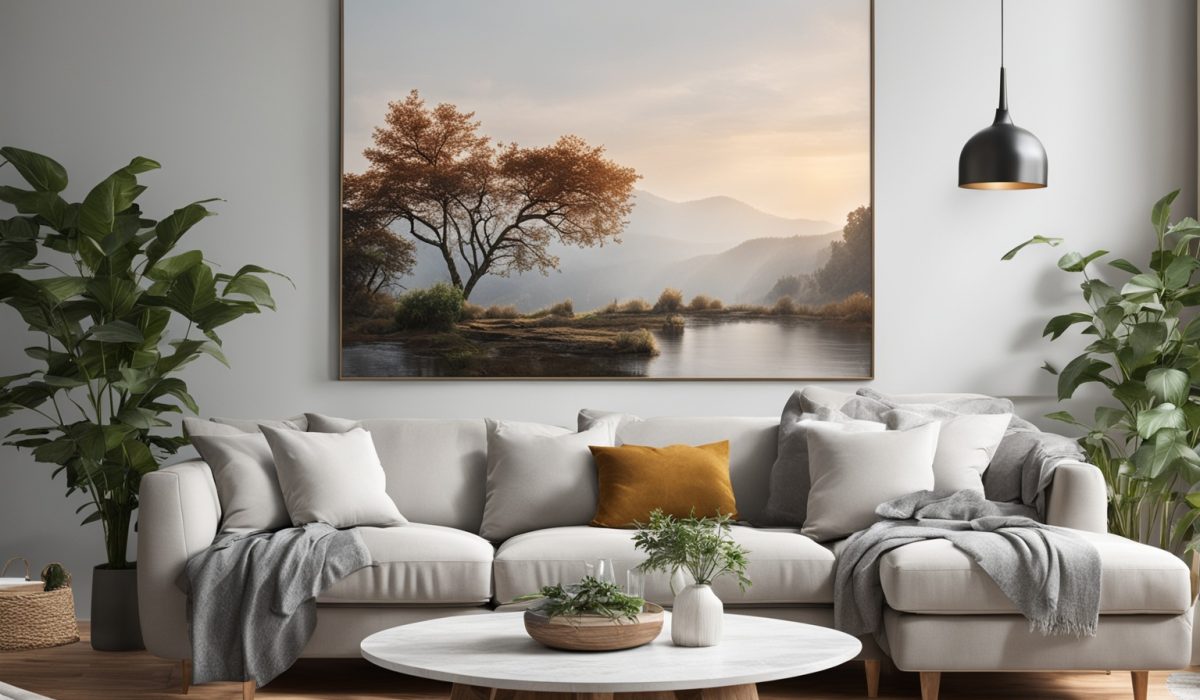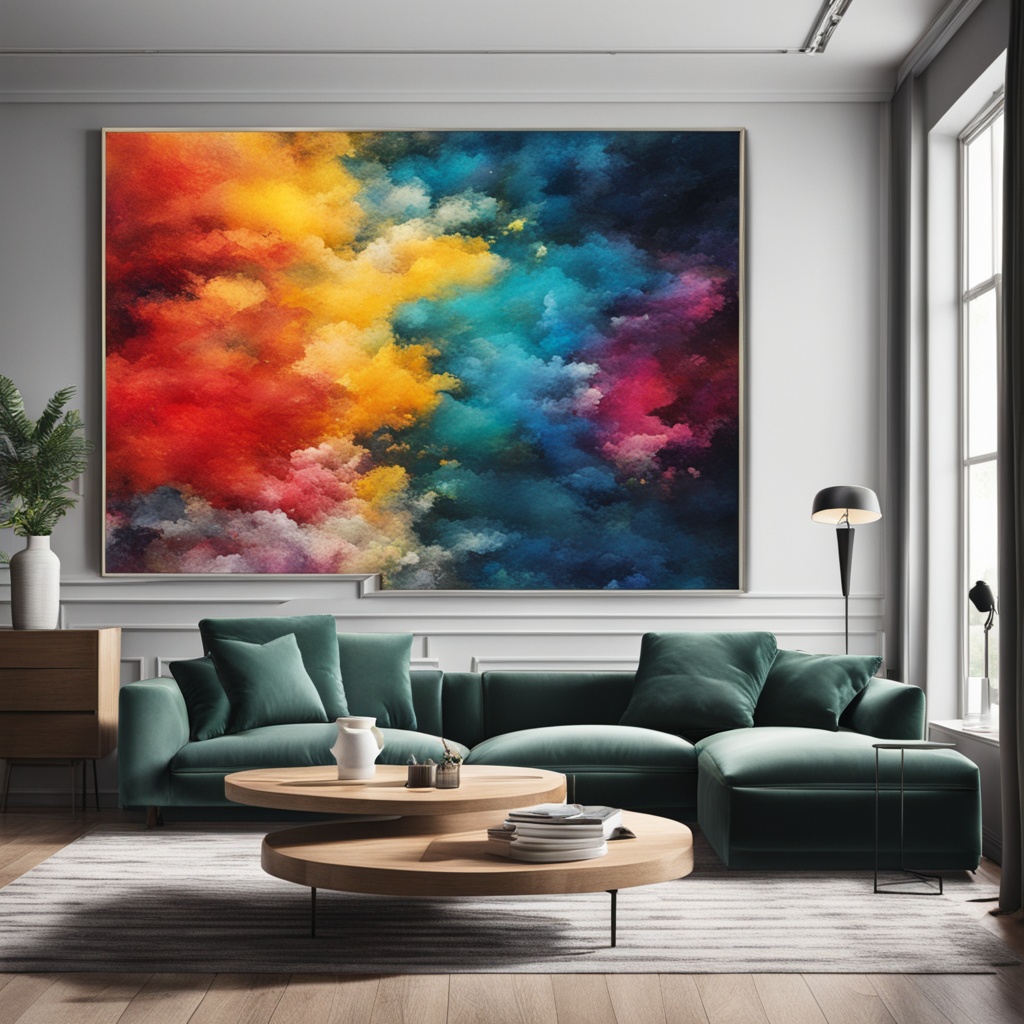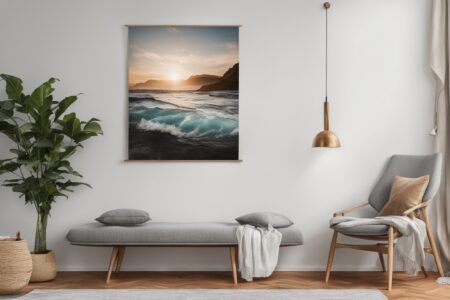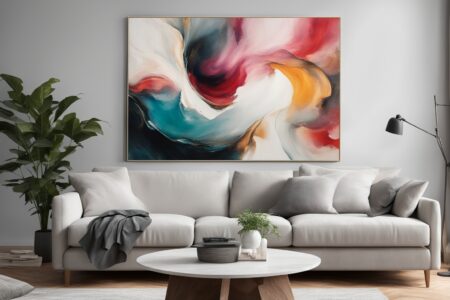Best Wall Art for Living Room: Top Picks to Elevate Your Space

Transforming your living room into a stylish and inviting space begins with selecting the best wall art to complement your decor. To make the right choice, it’s essential to understand your living room style and how to choose the right size and scale for your artwork. Exploring popular wall art styles and themes can provide inspiration, while considering the benefits of framed art vs. canvas prints will help you decide on the best medium. Incorporating colour and texture into your wall art can enhance the overall aesthetic, and for those who enjoy a personal touch, DIY wall art ideas offer a creative outlet. Properly arranging wall art is crucial to achieving a cohesive look, and knowing where to buy quality wall art ensures you find pieces that fit your vision. Additionally, there are plenty of budget-friendly wall art options available for those looking to decorate without breaking the bank. By following these guidelines, you can elevate your living room with stunning wall art that reflects your personal style.
CONTENT
Understanding Your Living Room Style
Identifying Your Design Aesthetic
Before selecting wall art, it’s important to identify your design aesthetic. Whether your living room exudes a modern, minimalist vibe or leans towards a cosy, rustic charm, understanding your style will guide your art choices. Take note of the existing furniture, colour palette, and decorative elements in your space. Are there any dominant themes or motifs? Do you prefer clean lines and neutral tones, or are you drawn to bold colours and eclectic patterns? By pinpointing your aesthetic, you can choose wall art that complements and enhances the overall look and feel of your living room, ensuring a harmonious and cohesive environment.
Considering Function and Mood
The function and mood of your living room play a crucial role in determining the best wall art. Consider how you use the space—whether it’s for entertaining guests, relaxing with family, or a mix of both. The mood you wish to create, be it serene and calming or vibrant and energetic, should influence your art selection. For a tranquil atmosphere, opt for soothing landscapes or abstract pieces with soft hues. If you aim to energise the room, choose dynamic artworks with bold colours and striking designs. Aligning your wall art with the intended function and mood will enhance the overall ambiance and make the space more inviting.
Harmonising with Existing Decor
Harmonising your wall art with existing decor is essential for a cohesive look. Start by examining the colours, textures, and patterns already present in your living room. Your wall art should either complement or contrast these elements in a balanced way. For instance, if your room features a lot of neutral tones, a vibrant piece of art can add a pop of colour and become a focal point. Conversely, if your decor is already colourful, consider more subdued artworks to avoid overwhelming the space. Additionally, think about the style of your furniture and accessories. Matching the art style with your decor, whether it’s modern, traditional, or eclectic, will create a unified and aesthetically pleasing environment.
Choosing the Right Size and Scale
Selecting the right size and scale for your wall art is crucial to achieving a balanced look in your living room. The first step is to measure the available wall space where you plan to hang the artwork. As a general rule, the art should take up about two-thirds to three-quarters of the wall space above a piece of furniture. For example, if you are placing art above a sofa, the width of the artwork should be roughly two-thirds the width of the sofa. This proportion ensures that the art does not appear too small or too overwhelming, creating a harmonious visual relationship between the furniture and the wall art.
Another important consideration is the height at which you hang your wall art. The centre of the artwork should be at eye level, which is typically around 150 to 160 centimetres from the floor. If you are hanging art above furniture, such as a sofa or console table, ensure there is a gap of about 15 to 25 centimetres between the top of the furniture and the bottom of the artwork. This spacing helps to create a cohesive look and prevents the art from appearing disconnected from the rest of the decor. Additionally, when arranging multiple pieces, treat them as a single unit and follow the same guidelines for height and spacing.
The scale of the artwork in relation to the room’s overall size is also important. In larger living rooms, you can opt for bigger, more dramatic pieces that make a bold statement. Conversely, in smaller spaces, it’s best to choose smaller artworks or a series of smaller pieces arranged in a gallery wall to avoid overwhelming the room. Consider the visual weight of the art as well; heavier, darker pieces can dominate a space, while lighter, more delicate artworks can add a touch of elegance without overpowering the room. By carefully considering the size and scale of your wall art, you can enhance the aesthetic appeal and balance of your living room.
Popular Wall Art Styles and Themes
Abstract Art
Abstract art is a popular choice for modern living rooms due to its ability to evoke emotion and spark conversation. Characterised by its use of shapes, colours, and forms rather than depicting real objects, abstract art allows for a high degree of personal interpretation. This style can range from bold and vibrant to soft and subtle, making it versatile enough to fit various decor themes. Abstract pieces often serve as a focal point in a room, drawing the eye and adding a dynamic element to the space. Whether you prefer geometric patterns, fluid brushstrokes, or a mix of both, abstract art can provide a unique and contemporary touch to your living room.
Nature and Landscape Art
Nature and landscape art brings the beauty of the outdoors into your living room, creating a serene and calming atmosphere. These artworks can depict anything from lush forests and tranquil beaches to majestic mountains and vibrant floral scenes. The natural elements in these pieces can help to soften a room’s aesthetic, making it feel more inviting and peaceful. Landscape art is particularly effective in spaces that aim to promote relaxation and comfort. The use of earthy tones and natural imagery can complement a variety of decor styles, from rustic and traditional to modern and minimalist, making it a versatile choice for any living room.
Modern and Minimalist Art
Modern and minimalist art is perfect for those who appreciate clean lines, simple forms, and a clutter-free aesthetic. This style often features monochromatic colour schemes, geometric shapes, and a focus on negative space. The simplicity of minimalist art can make a powerful statement without overwhelming the room, providing a sense of balance and harmony. Modern art, on the other hand, can include a broader range of styles but typically emphasises innovation and contemporary themes. Both modern and minimalist artworks can enhance a living room by adding a touch of sophistication and elegance. These styles are particularly well-suited for urban and contemporary interiors, where they can seamlessly blend with sleek furniture and minimalist decor.
Framed Art vs. Canvas Prints
Framed art offers a classic and polished look that can add a touch of elegance to any living room. Frames come in various materials, such as wood, metal, and plastic, allowing you to choose one that complements your existing decor. The addition of a frame can also protect the artwork from damage and make it easier to hang. Framed pieces often include a mat, which adds an extra layer of sophistication and helps to highlight the art itself. This option is particularly well-suited for traditional or formal living rooms, where the frame can enhance the overall aesthetic and provide a finished, professional appearance.
Canvas prints, on the other hand, offer a more contemporary and versatile option for displaying art. Unlike framed art, canvas prints are typically stretched over a wooden frame, giving them a three-dimensional quality that can add depth to your living room. The absence of a traditional frame allows the artwork to take centre stage, making it a great choice for modern and minimalist interiors. Canvas prints can also be more affordable than framed art, as they do not require additional materials like glass or matting. This makes them an excellent option for those looking to decorate on a budget without sacrificing style.
When deciding between framed art and canvas prints, consider the overall look and feel you want to achieve in your living room. Framed art can provide a more formal and structured appearance, while canvas prints offer a relaxed and contemporary vibe. Additionally, think about the practical aspects, such as ease of hanging and maintenance. Framed pieces may require more care to keep the glass clean and free of dust, whereas canvas prints are generally easier to maintain. Ultimately, the choice between framed art and canvas prints will depend on your personal style preferences and the specific needs of your living room decor.

Incorporating Colour and Texture
Using Colour to Set the Mood
Colour plays a pivotal role in setting the mood of your living room, and your choice of wall art can significantly influence this atmosphere. Warm colours like reds, oranges, and yellows can create a lively and energetic environment, perfect for social spaces where you entertain guests. Conversely, cool colours such as blues, greens, and purples can evoke a sense of calm and relaxation, making them ideal for a more tranquil setting. Neutral tones like beige, grey, and white can provide a sophisticated backdrop that allows other elements in the room to shine. By carefully selecting wall art that incorporates these colours, you can enhance the desired mood and create a cohesive look that ties the entire room together.
Adding Depth with Texture
Texture in wall art can add a layer of depth and interest to your living room decor. Textured pieces, such as those with thick paint applications, mixed media elements, or fabric components, can create a tactile experience that draws the eye and invites closer inspection. These artworks can break the monotony of flat surfaces and add a dynamic element to the room. For instance, a canvas with raised brushstrokes or a collage with layered materials can provide a sense of movement and dimension. Incorporating textured art can also complement other textured elements in the room, such as rugs, cushions, and upholstery, creating a rich and multi-dimensional space.
Balancing Bold and Subtle Elements
Achieving a balanced look in your living room involves carefully mixing bold and subtle elements in your wall art. Bold pieces with striking colours and dramatic designs can serve as focal points, capturing attention and adding a sense of excitement to the room. However, too many bold elements can overwhelm the space, making it feel chaotic. To counterbalance this, incorporate more subtle artworks that feature softer colours and simpler designs. These pieces can provide visual relief and help to create a harmonious environment. By thoughtfully combining bold and subtle elements, you can achieve a dynamic yet balanced aesthetic that enhances the overall appeal of your living room.
DIY Wall Art Ideas
Creating your own wall art can be a rewarding and cost-effective way to personalise your living room decor. One popular DIY idea is to create a gallery wall using a mix of personal photographs, prints, and small artworks. Start by selecting a theme or colour scheme to ensure a cohesive look. Arrange the pieces on the floor before hanging them to find the perfect layout. You can use frames of different sizes and styles to add visual interest, or keep it uniform for a more streamlined appearance. This approach allows you to showcase your personality and memories, making your living room feel uniquely yours.
Another creative DIY wall art idea is to make abstract paintings using acrylic or watercolour paints. Abstract art is forgiving and allows for a high degree of experimentation, making it perfect for beginners. You can use various techniques such as pouring, splattering, or brushstrokes to create unique patterns and textures. Choose colours that complement your living room’s existing decor to ensure the artwork integrates seamlessly into the space. Not only will this add a splash of colour and creativity to your walls, but it also provides a fun and relaxing activity that you can enjoy solo or with family and friends.
For those who enjoy working with textiles, creating a fabric wall hanging can add a touch of warmth and texture to your living room. You can use materials like yarn, fabric scraps, or even macramé to craft a piece that reflects your style. Weaving, knotting, or sewing techniques can be employed to produce intricate designs or simple, minimalist patterns. Fabric wall hangings are versatile and can be customised in terms of size, colour, and texture to match your decor. This type of wall art not only adds a cosy, handmade element to your living room but also serves as a conversation starter, showcasing your creativity and craftsmanship.
Tips for Arranging Wall Art
Creating a Focal Point
When arranging wall art, creating a focal point can help anchor the room and draw the eye to a specific area. Choose a statement piece that stands out due to its size, colour, or design, and place it in a prominent location, such as above the sofa or fireplace. This focal piece can serve as the centre of your arrangement, with smaller, complementary artworks radiating outwards. Ensure that the focal point is at eye level to maximise its impact. By establishing a central piece of art, you can create a cohesive and visually appealing arrangement that enhances the overall aesthetic of your living room.
Maintaining Balance and Symmetry
Balance and symmetry are key principles to consider when arranging wall art. Symmetrical arrangements, where artworks are evenly spaced and mirror each other, can create a sense of order and harmony. This approach works well in formal or traditional living rooms. For a more dynamic and contemporary look, consider an asymmetrical arrangement. While this may seem more casual, it still requires careful planning to ensure visual balance. Pay attention to the size, colour, and spacing of each piece. Mixing different shapes and orientations can add interest, but make sure the overall composition feels balanced. Achieving the right balance will make your wall art arrangement look intentional and well-thought-out.
Using a Gallery Wall
A gallery wall is an excellent way to display multiple pieces of art in a cohesive and stylish manner. Start by selecting a variety of artworks that share a common theme, colour scheme, or style. Lay out the pieces on the floor to experiment with different arrangements before committing to a final layout. When hanging the art, begin with the central piece and work your way outwards, maintaining consistent spacing between each item. Mixing different frame styles and sizes can add visual interest, but ensure there is a unifying element to tie the collection together. A well-curated gallery wall can transform a blank space into a vibrant and personalised feature in your living room.
Where to Buy Quality Wall Art
Local art galleries are excellent places to find high-quality wall art that is unique and often locally produced. Visiting a gallery allows you to see the artwork up close, appreciate the details, and even meet the artists behind the pieces. Many galleries feature a range of styles and mediums, from paintings and prints to sculptures and mixed media works. Additionally, purchasing from a gallery supports local artists and contributes to the cultural vibrancy of your community. Galleries often have knowledgeable staff who can provide insights into the art and help you choose pieces that fit your living room’s aesthetic.
Online art marketplaces offer a convenient way to browse and purchase wall art from the comfort of your home. Websites like Etsy, Saatchi Art, and Society6 feature a vast array of artworks from artists around the world. These platforms allow you to filter searches by style, size, price, and medium, making it easier to find pieces that match your preferences. Customer reviews and ratings can also provide valuable information about the quality and reliability of the sellers. While buying art online can be more affordable, it’s important to read the descriptions carefully and check return policies to ensure you are satisfied with your purchase.
Home decor stores and department stores are also reliable sources for quality wall art. Retailers like IKEA, West Elm, and Pottery Barn offer a wide selection of prints, framed art, and canvas pieces that cater to various tastes and budgets. These stores often feature curated collections that align with current design trends, making it easier to find art that complements your living room decor. Additionally, many home decor stores offer seasonal sales and discounts, providing an opportunity to purchase quality art at reduced prices. Shopping at these stores allows you to see the pieces in person and envision how they will look in your space, ensuring a more confident purchase decision.
Budget-Friendly Wall Art Options
Prints and Posters
Prints and posters are an affordable and versatile option for decorating your living room walls. Available in a wide range of styles, themes, and sizes, they can easily match any decor. Online platforms like Etsy, Redbubble, and Amazon offer a vast selection of prints and posters from independent artists and designers. You can find everything from vintage movie posters and botanical prints to abstract art and inspirational quotes. To give your prints a polished look, consider framing them yourself using budget-friendly frames from stores like IKEA or Kmart. This approach allows you to create a cohesive and stylish gallery wall without breaking the bank.
Thrift Stores and Flea Markets
Thrift stores and flea markets are treasure troves for budget-friendly wall art. These places often have a diverse assortment of pre-loved artworks, including paintings, prints, and photographs, at a fraction of the cost of new pieces. The thrill of the hunt can lead to discovering unique and one-of-a-kind items that add character and charm to your living room. When shopping at thrift stores or flea markets, keep an open mind and be prepared to spend some time browsing through the offerings. You might find hidden gems that only require a little cleaning or a new frame to look fantastic. This sustainable approach to decorating not only saves money but also gives new life to previously owned art.
DIY Art Projects
Creating your own wall art is a cost-effective way to personalise your living room decor. DIY art projects can range from simple to complex, depending on your skill level and creativity. For beginners, consider making abstract paintings using acrylic or watercolour paints, or try your hand at creating a collage with magazine cutouts and scrapbook materials. More advanced DIY enthusiasts might enjoy projects like macramé wall hangings, fabric art, or even creating custom stencils for unique designs. There are countless tutorials and inspiration available online to guide you through the process. DIY art not only saves money but also adds a personal touch to your living room, making the space truly your own.
Conclusion and Key Takeaways
Selecting the best wall art for your living room involves understanding your personal style, considering the size and scale of the artwork, and exploring various styles and themes. By identifying your design aesthetic and the mood you wish to create, you can choose pieces that complement your existing decor and enhance the overall ambiance of the room. Whether you prefer abstract art, nature scenes, or modern minimalist designs, the right wall art can transform your living space into a reflection of your personality and taste.
When it comes to displaying your chosen pieces, paying attention to the arrangement and presentation is crucial. Creating a focal point, maintaining balance and symmetry, and considering the use of a gallery wall can all contribute to a cohesive and visually appealing setup. Additionally, incorporating elements of colour and texture can add depth and interest to your living room, making it a more dynamic and inviting space. Whether you opt for framed art or canvas prints, the way you arrange and present your wall art can significantly impact the overall look and feel of the room.
Finally, there are numerous options for sourcing quality wall art that fits your budget. From local art galleries and online marketplaces to thrift stores and DIY projects, you can find or create pieces that enhance your living room without overspending. By exploring different avenues and considering budget-friendly options like prints, posters, and second-hand finds, you can decorate your space stylishly and affordably. Ultimately, the key to elevating your living room with wall art lies in thoughtful selection, creative arrangement, and a willingness to explore various sources and styles.






